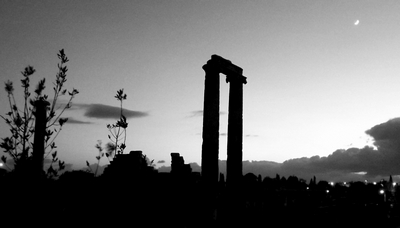Seemingly marooned indefinitely within the sleeping lockdown city which these days is London, I have managed to continue to keep in touch with events going on and around the Temple of Apollo thanks to Voices and my friends within Didim, writes Glenn Maffia.
Therefore, I shall recount some of the issues which have revealed themselves during my extended, and reluctant, hiatus.
Water Source
I first noticed that the area to the southeast corner of the temple was becoming somewhat sodden and squelchy underfoot during the summer of 2016, a year when the German archaeologists never received permission to continue with their excavations.
I initially felt the cause of this inundation was due to the reopening and increasingly heavy use of the road which snakes itself around the temple.
You may or may not remember, but this road was closed for one year on the request of the archaeologists, as its continued usage was considered to be a threatening factor on the wellbeing of the continued existence of this unique structure of antiquity.
Slowly but inexorably people began to flaunt this decree, apparently only closing the road when the archaeologists were in town. I recall having a beer with one (prior to any leakage of water) in one of the cafés which skirt the temple when he saw a tractor roll by, “He cannot do that! He cannot do that!”. “They open it when you guys aren’t here”, I replied. Therefore, to me, the reopened road and the flowing water were indelibly linked.
The Germans only witnessed the event when they arrived in August 2017 and concluded, eventually, that the karst rock which makes-up the Milesian peninsula had buckled in the large earthquake which occurred during July of that year resulting in groundwater being released from its subterranean basin.
I was impressed by this scientific explanation, especially when they carried out numerous below surface electronic readings, certain small excavations and mapping of the subterranean flow of the water. Their confidence on this being re-enforced by the arrival of a prominent hydrologist from Germany.
However, that turned into a damp squib when Didim water engineers, nagged persistently by the local population of Yoran village as the stagnant water stank, found merely a broken water feeder pipe.
I do not expect that the myriad of frogs, mosquitoes, snakes and the occasional duck, yes, I have seen a few, shall be too content this issue has been, hopefully, resolved. Though, I do question if this important issue has found a full resolution if this ‘guilty’ road continues to be in constant usage.
I do not believe the locals, nor the holidaymakers who visit, fully appreciate the rich value which this unmatched ancient site truly offers, not only Didim but, to Turkish tourism as a whole.
The last time I counted there were 18 cafés encircling the temple, all of which stand upon further archaic structures of infinite importance. I am sure that most caring people should agree that much, much more protection is due to the entire archaeological site.
We should be addressing this matter of concern with some immediacy. When I spoke to the people at the Miletus Museum I was told the protected area has increased three times since the initial area was established in 1978. But I see scant evidence of such a claim.
